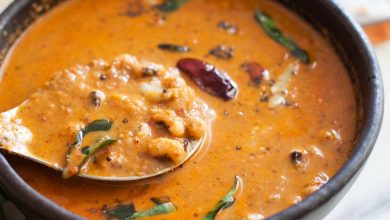Ragi or Finger Millet Powder/Malt Recipe for Babies (6 Months & Above)
Introduction
Ragi, also known as finger millet, is one of the most nutritious and healthy grains. Rich in calcium, protein, and iron, it is especially beneficial for infants and growing children. This traditional recipe outlines how to make Ragi powder from scratch, which can be used as a versatile ingredient for porridge, dosa, or other recipes. This homemade Ragi powder ensures your baby receives the best nutrients without additives or preservatives.
Recipe Summary
| Feature | Description |
|---|---|
| Recipe Name | Ragi or Finger Millet Powder/Malt Recipe for Babies (6 Months & Above) |
| Cuisine | Indian |
| Course | High Protein Vegetarian |
| Diet | Vegetarian |
| Servings | 10 |
| Prep Time | 14 hours (includes sprouting and drying) |
| Cook Time | 10 minutes |
| Total Time | 14 hours 10 minutes |
Ingredients
| Ingredient | Quantity |
|---|---|
| Sprouted Ragi | 1 cup |
Nutritional Information (Per Serving)
| Nutrient | Amount |
|---|---|
| Calories | 72 kcal |
| Protein | 1.3 g |
| Fat | 0.2 g |
| Carbohydrates | 15 g |
| Fiber | 1.8 g |
| Iron | 1.1 mg |
| Calcium | 30 mg |
Instructions
Step 1: Sprouting the Ragi Seeds
Sprouting enhances the nutritional profile of Ragi, making it easier to digest and more suitable for babies.
- Rinse Ragi Seeds: Place 1 cup of Ragi seeds in a bowl, and rinse them under running water to remove any dust or impurities.
- Soak Overnight: Soak the rinsed Ragi seeds in water for about 8-10 hours or overnight.
- Drain and Sprout: After soaking, drain the water and tie the Ragi seeds in a clean muslin cloth or cheesecloth. Keep them in a warm, dark place for 24 hours to allow sprouting.
Step 2: Drying the Sprouted Ragi
- Transfer to a Plate: Once sprouted, transfer the Ragi seeds to a large plate or tray.
- Shade Drying: Dry the Ragi in a shaded area for 4-5 hours, ensuring no direct sunlight exposure, which can reduce its nutrient content.
- Check for Moisture: Ensure the Ragi seeds are completely dry before proceeding to the next step.
Step 3: Roasting the Dried Ragi Sprouts
- Heat a Pan: Place a large pan on low heat and allow it to warm up slightly.
- Roast the Ragi: Add the dried sprouted Ragi to the pan. Roast on low flame for 5 minutes, stirring continuously to prevent burning. Roasting enhances the aroma and flavor while helping to retain nutrients.
- Cool the Seeds: Once roasted, remove the Ragi seeds from the pan and allow them to cool completely.
Step 4: Grinding and Sieving the Ragi Powder
- Grind to Powder: Once the seeds have cooled, transfer them to a mixer or grinder and grind to a fine powder.
- Sieve the Powder: Pour the ground Ragi powder through a fine sieve to remove any coarse grains. This step ensures a smooth, fine consistency, which is ideal for baby food.
- Store the Powder: Store the fine Ragi powder in an airtight container in a cool, dry place. This powder can be stored for up to 3 months and used as needed.
Serving Suggestions
With this homemade Ragi powder, you can prepare a variety of nutritious recipes for babies, including:
-
Ragi Porridge (Kanji): Mix 1-2 teaspoons of Ragi powder with water, cook over low heat, and stir continuously to avoid lumps. You may add milk or jaggery once the baby is older, depending on your preference.
-
Ragi Dosa: Combine the Ragi powder with rice flour, water, and a pinch of salt to create a thin batter. Pour it onto a hot pan to make dosa.
-
Ragi & Oats Rava Idli: Mix Ragi powder with oats and rava (semolina) to make a soft, steamed idli batter perfect for breakfast.
Tips for Making the Best Ragi Powder for Babies
- Fresh Ingredients: Always use fresh, high-quality Ragi seeds.
- Proper Storage: Store Ragi powder in an airtight container in a cool, dry place, and avoid moisture exposure.
- Roasting: Low-heat roasting is key to preserving the nutrients while enhancing flavor.
- Hygiene: Clean the grinding equipment thoroughly before use to avoid contamination.
Health Benefits of Ragi for Babies
Ragi, a highly nutritious grain, is particularly beneficial for infants due to its rich content of iron, calcium, protein, and dietary fiber. This ancient grain not only supports strong bones and teeth development but also aids in digestion and is a natural energy booster.




